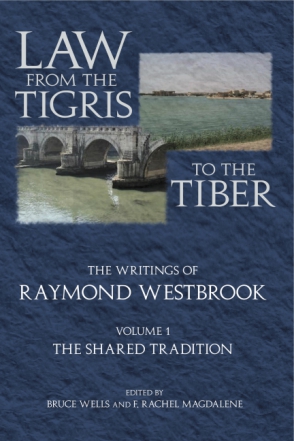
Law from the Tigris to the Tiber
The Writings of Raymond Westbrook
Raymond Westbrook, and Edited by Bruce Wells and F. Rachel Magdalene
Law from the Tigris to the Tiber
The Writings of Raymond Westbrook
Raymond Westbrook, and Edited by Bruce Wells and F. Rachel Magdalene
Raymond Westbrook (1946–2009) was acknowledged by many as the world’s foremost expert on the legal systems of the ancient Near East and a leading scholar in the study of biblical and classical law. This collection brings together the 44 most important articles that Westbrook published in the 25 years following the completion of his Ph.D. at Yale University in 1982. The first volume, The Shared Tradition, contains 16 articles that lay out Westbrook’s theory of a common legal tradition that spanned the ancient world from Mesopotamia to Israel and even to Greece and Rome. The second volume, Cuneiform and Biblical Sources, provides 28 articles that demonstrate Westbrook’s unique method of legal analysis that he applied to the numerous texts he worked with as an Assyriologist and biblical scholar, from law codes to contracts to narratives. Each volume contains its own comprehensive bibliography, as well as subject, author, and text indexes. Together, they represent the life’s work of one of the most important legal historians of our era.
- Description
- Table of Contents
Volume One: The Shared Tradition
Preface
Introduction
Part One: The Tradition in the Law Codes
1. Biblical and Cuneiform Law Codes
2. The Nature and Origins of the Twelve Tables
3. Cuneiform Law Codes and the Origins of Legislation
4. What Is the Covenant Code?
5. Codification and Canonization
6. Codex Hammurabi and the Ends of the Earth
Part Two: The Tradition in Legal Practice
7. Social Justice in the Ancient Near East
8. Slave and Master in Ancient Near Eastern Law
9. Patronage in the Ancient Near East
10. Adultery in Ancient Near Eastern Law
11. Witchcraft and the Law in the Ancient Near East
Part Three: The Tradition in Greco-Roman Law
12. The Trial Scene in the Iliad
13. Penelope’s Dowry and Odysseus’ Kingship
14. The Coherence of the Lex Aquilia
15. Restrictions on Alienation of Property in Early Roman Law
16. Vitae Necisque Potestas
Abbreviations
Bibliography
Index of Authors
Index of Subjects
Index of Ancient Sources
Volume Two: Cuneiform and Biblical Law
Preface
About the Editors
Introduction: Law as Method
Part One: Cuneiform Sources
1. The Edict of Tudhaliya IV
2. Hard Times: CT 45 37
3. The Liability of an Innocent Purchaser of Stolen Goods in Early Mesopotamian Law
4. The Old Babylonian Term nap arum
5. The Phrase ‘His Heart Is Satisfied’ in Ancient Near Eastern Legal Sources
6. The Case of the Elusive Debtors: CT 4 6a and CT 6 34b
7. Social Justice and Creative Jurisprudence in Late Bronze Age Syria
8. A Death in the Family: Codex Eshnunna 17-18 Revisited
9. The Adoption Laws of Codex Hammurabi
10. The Female Slave
11. A Sumerian Freedman
12. The Quality of Freedom in Neo-Babylonian Manumissions
13. Judges in the Cuneiform Sources
14. Evidentiary Procedure in the Middle Assyrian Laws
15. ziz2.da/kishshatum
16. The Enforcement of Morals in Mesopotamian Law
17. A Matter of Life and Death
18. International Law in the Amarna Age
19. Babylonian Diplomacy in the Amarna Letters
Part Two: Biblical Sources
20. Biblical Law
21. The Laws of Biblical Israel
22. Lex Talionis and Exodus 21:22-25
23. The Deposit Law of Exodus 21:6-12
24. Who Led the Scapegoat in Leviticus 16:21?
25. The Prohibition on Restoration of Marriage in Deuteronomy 24:1-4
26. Riddles in Deuteronomic Law
27. The Trial of Jeremiah
28. Legalistic ‘Glosses’ in Biblical Narratives
Abbreviations
Bibliography
Index of Authors
Index of Subjects
Index of Ancient Sources
Mailing List
Subscribe to our mailing list and be notified about new titles, journals and catalogs.



